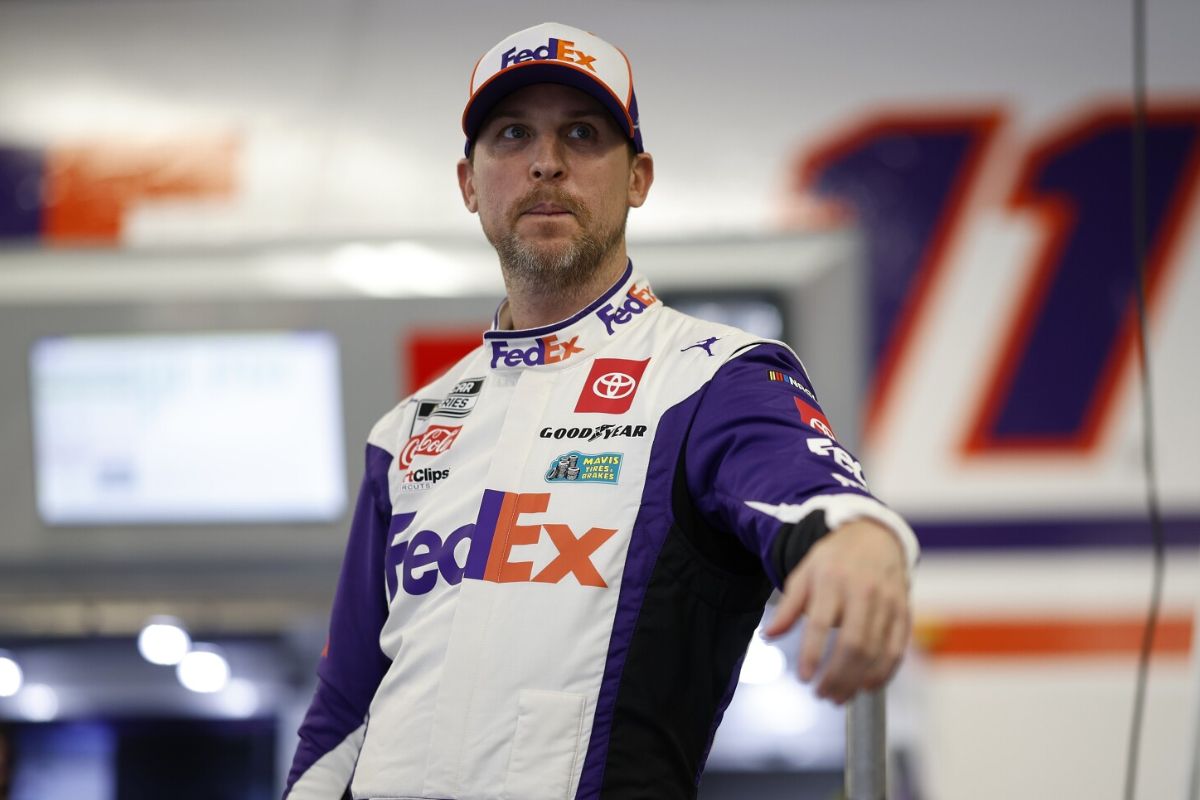Denny Hamlin’s Pylon Mockery: The recent incident involving Denny Hamlin’s public mockery of NASCAR’s decision to remove pylons has stirred considerable controversy among the racing community. Hamlin, leveraging his high-profile victory, criticized this significant change, prompting a wave of reactions ranging from support to severe disapproval from fans and stakeholders similarly. This situation raises critical questions about the balance between modernizing the sport and preserving its traditional elements, which have long contributed to its unique character and appeal.
Key Takeaways
- Denny Hamlin criticized NASCAR’s decision to remove pylons, using his race victory to publicly address the issue.
- Fans expressed dissatisfaction, highlighting concerns about race safety, integrity, and the loss of a cherished tradition.
- The removal sparked debate among stakeholders about potential negative impacts on race quality and fan engagement.
- Hamlin’s actions intensified discussions on balancing NASCAR’s traditions with modernization, reflecting broader athlete influence in sports governance.
Denny Hamlin’s Pylon Protest Rocks NASCAR Fans
Denny Hamlin’s vocal opposition to the placement of the scoring pylon at Talladega Superspeedway, tri-oval track sparked significant unrest among NASCAR enthusiasts. Hamlin’s protest show a broader conversation about the intersection of race strategy and driver safety, resonating deeply with the racing community. The pylon, designed to provide real-time updates of the top 10 drivers, became a focal point of debate not just for its functionality but for its situated visibility and potential distraction.
Analyzing the implications of Hamlin’s protest requires an understanding of the operational dynamics at NASCAR races. The pylon’s placement, while meant to improve spectator experience and driver awareness, also intersects important sightlines on one of NASCAR’s fastest tracks. Hamlin’s critique brought to the forefront the necessity for a balance between informational utility and environmental integration on the race track.
Hamlin’s Bold Pylon Statement
Amidst ongoing controversy, Hamlin’s recent victory at Dover was marked by a defiant display, as he publicly criticized NASCAR’s decision to remove the scoring pylon through a pointed social media post. This bold gesture not only highlights his disapproval but also emphasizes a deeper discord between the drivers and NASCAR’s administrative decisions. Hamlin’s act of posting an image of the scoring pylon, following his win, served as a symbolic protest and a rallying point for those opposing the recent changes.
| Aspect | Detail | Impact on Stakeholders |
|---|---|---|
| Symbolism | Pylon represents traditional racing culture. | Nostalgia and discontent. |
| Hamlin’s Role | Driver and implicit leader in the protest. | Amplifies driver concerns. |
| NASCAR’s Decision | Removal of iconic scoring pylons. | Sparks debate on modernization vs. tradition. |
| Fan Engagement | Fans’ reaction to Hamlin’s post. | Deepens fan involvement in governance issues. |
| Future Implications | Potential changes in NASCAR’s policies. | Uncertainty and anticipation among the racing community. |
Pylon works pic.twitter.com/Tv6HdJ0ARU
— Denny Hamlin (@dennyhamlin) April 29, 2024
Fans React to Hamlin’s Mockery
The reaction has been a blend of nostalgia, irritation, and complex sentimentality, indicating a divisive atmosphere among fans. On one hand, Hamlin’s passion for the traditional elements of NASCAR resonates with a segment of the audience that cherishes the historical aspects of the sport. The vivid memory of Hamlin’s 2013 lap record at Charlotte, culminating in his victory and the iconic role of the pylon in that moment, highlights the emotional connection some fans have with these physical symbols.
“Stop it Denny, you’ll scare Nascar!!”
“You just out here poking the bear.”-fans reaction
However, there’s a palpable backlash from another faction within the community. This group views Hamlin’s actions as an unnecessary provocation that distracts from the evolution of the sport. They argue that the focus should remain on the races and the drivers, not on what they perceive as outdated fixtures.
Fear of NASCAR’s Wrath
The fear of potential repercussions from NASCAR’s governing body has left some of Hamlin’s supporters urging caution in his public criticisms. This concern stems from NASCAR’s historical unpredictability in handling disputes and criticisms, which can sometimes result in unforeseen penalties or public reprimands. Fans express a palpable apprehension, suggesting that Hamlin’s humorous jabs might provoke a response from the regulatory authority that could have ramifications beyond a simple scolding.
“… until SMI realizes that they forgot about Dover. “Oh, we missed one.” -fans reaction
This anxiety is not without precedent. NASCAR has, over the years, demonstrated a capacity for stringent regulatory actions, which in some cases, have included fines, point deductions, or even suspension of team members. The metaphor of ‘poking the bear,’ used by one of Hamlin’s fans, represents the perceived risk of inciting NASCAR’s ire through public or even lighthearted criticism. This metaphor vividly illustrates the fear that NASCAR, when provoked, might respond in a severe and impactful manner.
Pylon works pic.twitter.com/Tv6HdJ0ARU
— Denny Hamlin (@dennyhamlin) April 29, 2024
Concerns Over Pylon Removal
Concerns about the removal of pylons at key NASCAR tracks have emerged from different stakeholders, highlighting financial and technical implications. The removal process, which has already occurred at Talladega, Bristol, and Watkins Glen, is seen as a strategic move to reduce costs and streamline operations.
On one hand, the financial implications of removing pylons are non-trivial. Although NASCAR cites cost reduction as a primary motivator, the initial outlay for dismantling existing structures and modifying track facilities to adapt to a pylon-free environment involves considerable expenditure. On the technical side, pylons serve as critical markers that assist drivers and teams in making strategic decisions during races. Their absence could lead to confusion and a potential decrease in the quality of racing, impacting the overall fan experience.
Value of Pylons to Drivers and Fans
Reflecting on the strategic and financial implications of pylon removal, it is paramount to contemplate their intrinsic value to both NASCAR drivers and fans, which highlights their role in enriching the racing experience. The Indianapolis Motor Speedway’s 33-position pylon, a symbol of modern technology in motorsports, encapsulates more than just the race standings. It provides real-time data important for strategic decision-making during races. This includes lap times, speeds, and time intervals, which are essential for drivers to adjust their tactics on the fly. Additionally, these metrics allow teams to execute informed strategies, potentially altering the course of the race based on dynamic race conditions.
From a fan’s perspective, the pylon transcends its functional role, morphing into a symbol of engagement and excitement. It fosters a deeper connection between the spectators and the unfolding narratives on the track by offering a clear, at-a-glance view of race progressions. This immediacy and transparency of information enrich the spectator’s experience, making it more interactive and comprehensible, especially for those new to the sport.
Considering the sentiments expressed by figures like Greg van Alst, the value of these pylons is palpable among the community. They are not merely infrastructural elements but are important in enhancing the competitive spirit and communal experience of motor racing.
“You can definitely see them when you’re on the track, so it’s nice to have them.”
“It’s nice for the spotter to be able to see them. I’m from the Indy area, so the most famous pylon in the world. I’m all for them. I’m not really a big fan (when) they started taking him away. I’m hoping it’s just they’re going to rebuild them or something.”- van Alst
News in Brief: Denny Hamlin’s Pylon Mockery
The controversy surrounding Denny Hamlin’s pylon mockery highlights a deep-seated disquiet within the NASCAR community, revealing profound concerns about safety, competition integrity, and the preservation of tradition.
This incident not only showcases the tensions between innovation and tradition but also underscores the critical role of driver feedback in shaping the sport’s regulations and practices.
Ultimately, this backlash may prompt NASCAR authorities to reassess their decision-making processes, ensuring that changes align with the core values and expectations of their dedicated fan base.
Our Reader’s Queries
Q. Who is the number 11 car in NASCAR?
A. Denny Hamlin pilots the No. 11 Toyota for Joe Gibbs Racing in the NASCAR Cup Series while also serving as co-owner of 23XI Racing alongside NBA icon Michael Jordan.
Q. How many Daytonas has Denny Hamlin won?
A. At 43 years old, this seasoned veteran may not boast a championship title, yet his career boasts an impressive tally of 51 wins, which notably includes three triumphs at the Daytona 500. It’s worth noting that in NASCAR history, only five drivers have secured as many or more victories at the 500s than Hamlin.
Q. Is Denny Hamlin a Hall of Famer?
A. At 43, he embodies multiple roles within the sport: entertainer, team owner, and a figure poised for future induction into the NASCAR Hall of Fame. Additionally, he perceives himself as a steward, responsible for nurturing the sport’s legacy.
ALSO READ: Denny Hamlin’s Shocking Confession About Helping NASCAR



